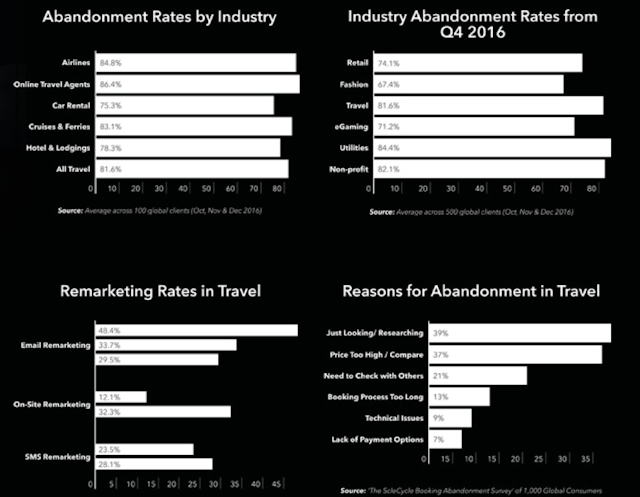How to avoid abandonment rates on travel websites
Nobody likes trawling through thousands of websites before beginning a booking process, especially for something that should be as straight forward as booking flights and a hotel for a relaxing getaway. Yet, recent stats covering the range of abandonment rates for websites over the last three months of 2016 show that travel sites have some of the highest abandonment rates online.

Abandonment rates
In spite of this, we know that web-based research is prominent in the digital era and that bloggers cannot source enough information to cover a full holiday package. It is not the purpose of travel sites that lack in lustre, and by sourcing the main culprit of this problem, it’s possible to adjust these websites in or der to minimise this problem.
The average abandonment rate of travel sites is a rocketing 81.6%. There are two reasons for this: travel purchases tend to be more expensive, and people take time over a decision.
This is apparent when we look at the breakdown of different types of travel website. People like to be given choice, but as demonstrated by every British comedian at least once in their career, we hate lengthy forms and online processes. The more complex the research and booking process, the higher the abandonment rate.
The travel consideration and booking process can also take a very long time. Indeed, a study from Millward Brown found that users booking holidays take up to 45 days and visit as many as 38 travel sites before buying, while our customer survey data also highlights the importance of research in the booking process.

How can travel sites reduce abandonment rates?
Travel sites don’t need to simply accept these abandonment rates. There is much they can do to reduce disinterest or persuade customers to return to the site and complete the purchase.
Addressing technical problems and providing a range of payment options for visitors are obvious answers, but sites can also work hard to assist customers as they research a purchase.
Be upfront and clear about pricing
Customers will often go through the entire booking process, only to abandon if they feel the final price is too expensive, or if hidden charges are added. The answer is simple: make sure the price shown at the start of checkout is the same at the end.
Help users to research holidays and destinations
If customers can find the answers on a site, the need to shop and research around the web reduces. Travel brands can create content around the destinations on offer, such as tourist attractions, restaurants and budget excursions.
Many sites, such as Thomson, now integrate TripAdvisor reviews and content on their pages. The inevitability of extra research is high, so it’s a smart move; customers can save time browsing the feedback on the same page, rather than seek this information elsewhere.
Remind people about their abandoned booking
Customers will abandon bookings but this doesn’t have to be the end. 87% of customers in our survey said they would consider returning to their booking after an abandonment.
By sending out an email around an hour after customers abandon carts, you stimulate interest by placing the thought back into the consumer’s mind. Thomas Cook uses this technique to show the holiday details and offer a fast route back to purchase, saving the customer the effort of entering all the details again.
Remarketing like this – whether on-site, email or SMS – works because it offers a useful reminder to customers, in addition to an easy way to return and complete a purchase they abandoned. Sometimes customers just need a gentle push to complete their purchase.
Pay attention to forms
Many travel bookings involve the need to add traveller details, children’s ages, passport numbers and more. This means travel booking forms tend to be longer and more complex than those for most online retailers. Travel sites can reduce form abandonment rates by making forms as easy to complete as possible. This includes testing forms to identify possible pain points, adapting input fields for the user’s device and being clear with error messaging.
The booking process doesn’t have to be a boring one; keep users intrigued by offering tips and deals, keeping forms short and precise and being clear on costs. Avoiding abandonment is dependable on customer service, and the effort put in to making a user ’s life easy will pay off in the long run.
Graham Charlton is editor in chief at Salecycle.
Content by The Drum Network member:

SaleCycle
Founded in 2010, SaleCycle is committed to helping the world’s top brands recover lost sales online.
We work with companies to help inspire, shape and support...
